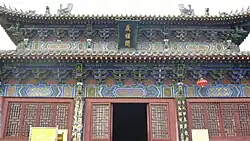Buddhist texts library
A Buddhist texts library (simplified Chinese: 藏经阁; traditional Chinese: 蔵經閣; pinyin: Cángjīnggé) is a large building in Chinese Buddhist temples which is built specially for storing The Chinese Buddhist Canon (大藏經). It is encountered throughout East Asia, including in some Japanese Buddhist Kyōzōs (経蔵). The Chinese Buddhist Canon is the total body of Buddhist literature deemed canonical and was called "all the sutras" (一切經) in the ancient time. With four thousand kinds, it includes Āgama (經), Vinaya (律) and Abhidharma (論) texts. Āgama are theories made by Buddha for disciples to practice, Vinaya are the rules formulated by Buddha for believers and Abhidharma is the collection of theories explanations by Buddha's disciples.[1][2]
| Buddhist texts library | |||||||
|---|---|---|---|---|---|---|---|
 | |||||||
| Traditional Chinese | 蔵經閣 | ||||||
| Simplified Chinese | 藏经阁 | ||||||
| Literal meaning | Buddhist Texts Library Buddhist Sutras Library | ||||||
| |||||||
A Buddhist texts library is generally two-storey buildings built at the highest point of the temple. The upper storey is for storing sutras and the lower layer is the "Thousand Buddha Pavilion" (千佛閣).[3]
References
- Wei Ran (2012-06-01). Buddhist Buildings. Beijing: China Architecture & Building Press. ISBN 9787112142880.
- Han Xin (2006-04-01). Well-Known Temples of China. Shanghai: The Eastern Publishing Co. Ltd. ISBN 7506024772.
- Zi Yan (2012-08-01). Famous Temples in China. Beijing: Time Publishing and Media Co., Ltd. pp. 48–50. ISBN 978-7-5461-3146-7.